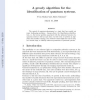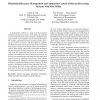1404 search results - page 16 / 281 » On optimal input design in system identification for control |
ICRA
2000
IEEE
13 years 11 months ago
2000
IEEE
By exploiting properties of the joint space mass-inertia matrix of flexure jointed hexapods, a new decoupling method is proposed. The new decoupling method, through a static input...
CDC
2009
IEEE
13 years 11 months ago
2009
IEEE
The control of quantum phenomena is a topic that has carried out many challenging problems. Among others, the Hamiltonian identification, i.e, the inverse problem associated with ...
ICDCS
2007
IEEE
14 years 2 months ago
2007
IEEE
A fundamental problem in a large scale decentralized stream processing system is how to best utilize the available resources and admission control the bursty and high volume input...
AUTOMATICA
2006
13 years 7 months ago
2006
A detailed study on the design of decentralized Receding Horizon Control (RHC) schemes for decoupled systems is presented. An optimal control problem is formulated for a set of de...
TSMC
2008
13 years 7 months ago
2008
This paper proposes a type-2 self-organizing neural fuzzy system (T2SONFS) and its hardware implementation. The antecedent parts in each T2SONFS fuzzy rule are interval type-2 fuzz...


